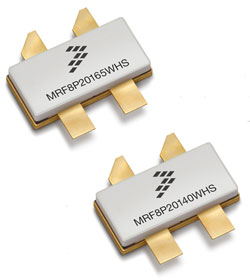
The RF power market possesses a healthy share of competitive suppliers, all eager to grab market share from one another. In order to lead the market, one must constantly innovate to offer the best-in-class products, optimized for the cellular infrastructure market space. In the past, customers were content to utilize devices that achieved the highest basic RF performance numbers based on gain, efficiency and linearity. Now customers are demanding those basic RF performance requirements and the ability of the devices to be easily Digital Pre-Distortion (DPD) error corrected.
One of the latest innovations for improved DPD capability is the concept of improved instantaneous bandwidth. By improving the in-package output matching structure and adding DC bias decoupling inside of the RF power device itself, one can significantly improve the ability of the device to amplify very wide bandwidth signals or multiple wideband modulated signals.
The instantaneous bandwidth capability of a device is limited by two controlling factors. One is the internal resonant frequency of the internal device output matching structure. This is easily controlled and set to very high frequencies, well above the 100 MHz range. The other limiting factor is the ability of the external circuit DC bias decoupling capacitors to supply enough current to the device at the high peak power demand of in phase, multiple carrier signals. The problem is that most of the decoupling capacitance is on the DC side of the RF blocking choke and that RF choke inductance limits the current delivery capability of the capacitors. The solution is to place some of that decoupling capacitance inside of the device on the RF side of the circuits' RF choke. Enhanced video bandwidth parts, or eVBW devices, have this technology installed and are capable of instantaneous bandwidths in the 100 to 140 MHz range.
Two of the newest enhanced video bandwidth devices released from Freescale are the MRF8P20140WH and the MRF8P20165WH. Both of these devices are presented in the symmetrical Doherty configuration in a NI780-4 air cavity ceramic package and are designed for the 2000 MHz LTE market space.

Figure 1 Two-tone IMD comparison between standard and eVBW devices.
The MRF8P20165WH has approximately 16 dB gain, 46 percent efficiency and -33 dBc adjacent channel power ratio at the 37 W output level with a single carrier wideband CDMA test signal at 1995 MHz. Its video bandwidth capability is on the order of 100 MHz, which is a 50 percent greater improvement over conventional designs.
The MRF8P20140WH has approximately 16 dB gain, 43 percent efficiency and -31 dBc adjacent channel power ratio at the 24 W output level with a single carrier wideband CDMA test signal at 1995 MHz. Its video bandwidth capability is on the order of 140 MHz, which is a 2× greater improvement over conventional designs.
Figure 1 shows a comparison of the two-tone intermodulation distortion products across various tone spacings for both a conventional device and an enhanced VBW capable part. With the conventional design, the third order imtermodulation product tends to start falling apart at about 55 MHz. The same devices with the patented Freescale matching structure are capable of maintaining good IMD numbers at tone spacings greater than 100 MHz.
These are just the latest improvements in a series of innovations that continuously add value for customers. The existence of multiple suppliers incentivizes competition. This forces a healthy amount of continuous innovation and development, which of course, always benefits the designer of cellular infrastructure power amplifiers.
Freescale Semiconductor
Austin, TX
(800) 521-6274
www.freescale.com
